XVIII Airborne Corps
The XVIII Airborne Corps is a corps of the United States Army that has been in existence since 1942 and saw extensive service during World War II. The corps is designed for rapid deployment anywhere in the world and is referred to as "America's Contingency Corps". Its headquarters are at Fort Bragg, North Carolina.
| II Armored Corps XVIII Corps XVIII Airborne Corps | |
|---|---|
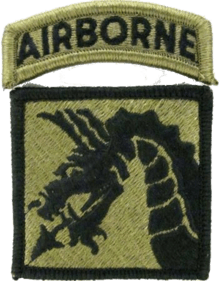 XVIII Army Airborne Corps shoulder sleeve insignia | |
| Active | 1942–1945 1951–present |
| Country | |
| Branch | |
| Type | Corps |
| Part of | |
| Garrison/HQ | Fort Bragg, North Carolina, U.S. |
| Motto(s) | Sky Dragons |
| Color of Beret | Maroon |
| Engagements | World War II
Persian Gulf War |
| Website | https://www.army.mil/xviiicorps |
| Commanders | |
| Current commander | LTG Michael “Erik” Kurilla[1] |
| Notable commanders | Matthew Ridgway John W. Leonard James J. Lindsay Thomas J. H. Trapnell William C. Westmoreland Henry E. Emerson Hugh Shelton |
| Insignia | |
| Combat service identification badge |  |
| Distinctive unit insignia | 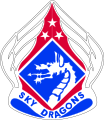 |
| Flag | 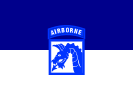 |
| Beret flash | 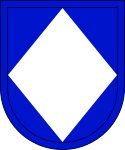 |
| Background trimming |  |
| U.S. Corps (1939–present) | |
|---|---|
| Previous | Next |
| XVII Corps (United States) | XIX Corps (United States) |
Leadership
Its command group includes:
- Commanding General: Lieutenant General Michael E. Kurilla[2]
- Deputy Commanding General: Major General Brian J. McKiernan[2]
- Deputy Commanding General (Operations): Brigadier General W. H. Fletcher, Canadian Army[2]
- Command Sergeant Major: Command Sergeant Major Charles Albertson[2]
History
World War II
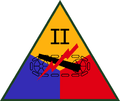 II Armored Corps
II Armored Corps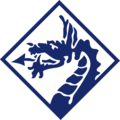 XVIII Corps
XVIII Corps XVIII Airborne Corps
XVIII Airborne Corps
The corps was first activated on 17 January 1942, five weeks after the entry of the United States into World War II, as the II Armored Corps at Camp Polk, Louisiana, under the command of Major General William Henry Harrison Morris, Jr.. When the concept of armored corps proved unnecessary, II Armored Corps was re-designated as XVIII Corps on 9 October 1943 at the Presidio of Monterey, California.
XVIII Corps deployed to Europe on 17 August 1944 and became the XVIII Airborne Corps on 25 August 1944 at Ogbourne St.George, England, assuming command of the 82nd and 101st Airborne Divisions, as part of the preparation for Operation Market Garden. Prior to this time the two divisions were assigned to VII Corps and jumped into Normandy during Operation Overlord, the Allied invasion of Normandy, as part of VII Corps.[3] Major General Matthew Bunker Ridgway, a highly professional, competent and experienced airborne commander who had led the 82nd Airborne Division in Sicily, Italy and Normandy, was chosen to command the corps, which then consisted of the 82nd and 101st Airborne Divisions and was part of the newly created First Allied Airborne Army.
The corps headquarters did not see service in Operation Market Garden, with the British I Airborne Corps being chosen instead to exercise operational command of all Allied airborne forces in the operation, including the 82nd and 101st Airborne Divisions.
Following the Battle of the Bulge, in which the corps played a significant part (and which, during the early stages of the battle, the corps was commanded by Major General James M. Gavin of the 82nd Airborne), all American airborne units on the Western Front fell under command of the corps. XVIII Airborne Corps planned and executed Operation Varsity, the airborne component of Operation Plunder, the crossing of the River Rhine into Germany. It was one of the largest airborne operations of the war, with the British 6th and U.S. 17th Airborne Divisions under command. The U.S. 13th Airborne Division was to participate in the assault. However, due to a lack of a sufficient number of transports, the division was unable to take part. After taking part in the Western Allied invasion of Germany, the XVIII Airborne Corps, still under Ridgway, returned to the United States in June 1945 and was initially to take part in the invasion of Japan, codenamed Operation Downfall. However, the Japanese surrendered just weeks later and XVIII Airborne Corps was inactivated on 15 October 1945 at Fort Campbell, Kentucky.
World War II units
- 1st Infantry Division — 26 January 1945 – 12 February 1945.
- 4th Infantry Division
- 8th Infantry Division — 26 January 1945 – 10 July 1945.
- 17th Airborne Division — 12 August 1944 – 1 January 1945; 15 February 1945 – 24 March 1945.
- 29th Infantry Division
- 30th Infantry Division — 21 December 1944 – 3 February 1945.
- 34th Infantry Division
- 75th Infantry Division — 29 December 1944 – 2 January 1945; 7 January 1945.
- 78th Infantry Division — 3 February 1945 – 12 February 1945.
- 82nd Airborne Division — 12 August 1944 – 17 September 1944; 19 December 1944 – 14 February 1945; 30 April 1945 – 3 January 1946.
- 84th Infantry Division — 20 December 1944 – 21 December 1944.
- 86th Infantry Division — 5 April 1945 – 22 April 1945.
- 89th Infantry Division
- 97th Infantry Division — 10 April 1945 – 22 April 1945.
- 101st Airborne Division — 12 August 1944 — 21 September 1944; 28 February 1945 – 1 April 1945.
- 106th Infantry Division — 20 December 1944 – 6 February 1945.
- 3rd Armored Division — 19 December 1944 – 23 December 1944.
- 5th Armored Division — 4 May 1945 – 10 October 1945.
- 7th Armored Division — 20 December 1944 – 29 January 1945; 30 April 1945 – 9 October 1945.
- 13th Armored Division — 10 April 1945 – 22 April 1945.
Cold War
The Corps was reactivated at Fort Bragg on 21 May 1951 under the command of Major General John W. Leonard. Since then, the corps has been the primary strategic response force, with subordinate units participating in over a dozen major operations (listed below) in both combat and humanitarian roles, primarily in Central America and the CENTCOM area of responsibility.
In 1958 the XVIII Airborne Corps was given the additional designation of the Strategic Army Corps. The designation was, in reality, the assignment of an additional mission rather than a true designation. The additional mission was to provide a flexible strike capability that could deploy worldwide on short notice without declaration of an emergency. The 4th Infantry Division at Fort Lewis, Washington, and the 101st Airborne Division at Fort Campbell, Kentucky, were designated as STRAC's first-line divisions, while the 1st Infantry Division at Fort Riley, Kansas, and the 82nd Airborne Division at Fort Bragg were to provide backup in the event of general war. The 5th Logistical Command (later inactivated), also at Fort Bragg, would provide the corps with logistics support, while Fort Bragg's XVIII Airborne Corps Artillery would control artillery units.[4]
The Corps deployed forces to the United States occupation of the Dominican Republic ('Operation Power Pack') in 1965.
The Corps deployed forces to the Vietnam War, to include the entire 101st Airborne division and the 3rd Brigade of the 82nd Airborne division.
In 1967 elements of the Corps were deployed to Detroit to suppress riots, and also to The Congo to support the government there and to rescue civilian hostages as part of Operation Dragon Rouge.
In 1982 the Corps first rotated elements to the Sinai Peninsula as part of the Multinational Force and Observers (UN) to guarantee the Camp David Peace Accords. [5]
In 1983 elements of the Corps were deployed to the Island of Grenada as part of Operation Urgent Fury, with the stated goal of reestablishing the democratically elected government.
In 1989 XVIII Airborne Corps, commanded by then LTG Carl Stiner, participated in the invasion of Panama in Operation Just Cause. Stiner served concurrently as Commander of Joint Task Force South.
Organization 1989

At the end of the Cold War in 1989 XVIII Airborne Corps consisted of the following units:
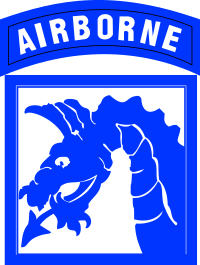
- Headquarters & Headquarters Company
- 18th Personnel Group
- 18th Finance Group[7]
- 4th Squadron, 17th Cavalry, Fort Campbell[8] (Operation Prime Chance OH-58D Kiowa Warrior equipped unit operating against Iran in the Persian Gulf)
- 1st Battalion, 2nd Air Defense Artillery, Fort Stewart[9]
- 2nd Battalion, 52nd Air Defense Artillery
- Army Band
.svg.png)


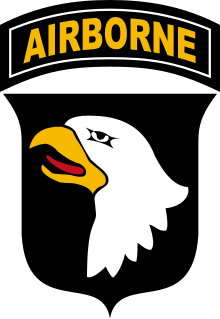

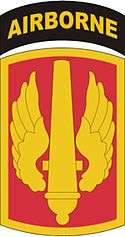
- Headquarters & Headquarters Battery
- 3rd Battalion, 8th Field Artillery (24 × M198 155mm towed howitzer)[11][12][10][13]
- 5th Battalion, 8th Field Artillery (24 × M198 155mm towed howitzer)[11][12][10][13]
- 3rd Battalion, 27th Field Artillery (27 × M270 Multiple Launch Rocket System)[11][12][10][13][14][15]
- 1st Battalion, 39th Field Artillery (Airborne) (24 × M198 155mm towed howitzer)[11][12][10][16]
- 1st Field Artillery Detachment (Target Acquisition)[15]
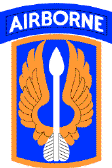
- Headquarters & Headquarters Company
- 1st Battalion, 58th Aviation (Air Traffic Control)[17]
- 1st Battalion, 159th Aviation (General Support)
- 2nd Battalion, 159th Aviation (Medium Lift)[18][19]
- 3rd Battalion, 159th Aviation (Attack)[20]
- 2nd Battalion, 229th Aviation (Attack) (former 2nd Battalion, 101st Aviation)[21]
- 3rd Battalion, 229th Aviation (Attack)
- 5th Battalion, 229th Aviation (Attack)
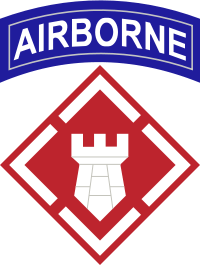
.svg.png)
- 503rd Military Police Battalion (Airborne)[29]
_-_SSI.png)
- 25th Signal Battalion (Corps Area)[31][30][32]
- 50th Signal Battalion (Corps Command Operations) (Airborne)[31][30][33]
- 327th Signal Battalion (Corps Radio)[31][30][34]
- 426th Signal Battalion (Corps Area)[31][30]
_-_SSI.png)
- 224th Military Intelligence Battalion (Aerial Exploitation), Hunter Army Airfield, Georgia[35][36]
- 319th Military Intelligence Battalion (Operations)[37]
- 519th Military Intelligence Battalion (Tactical Exploitation) (Airborne)[38]
_-_SSI.png)
- Headquarters & Headquarters Company
- Special Troops Battalion
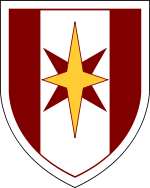
- Headquarters & Headquarters Detachment
- 32nd Medical Supply, Optical and Maintenance Battalion
- 5th Surgical Hospital[40]
- 28th Combat Support Hospital[41]
- 86th Evacuation Hospital, Fort Campbell[42]
- 36th Medical Company (Ambulance)[43]
- 46th Corps Support Group
- Headquarters & Headquarters Company
- 189th Maintenance Battalion[44]
- 530th Supply and Service Battalion
- 102nd Quartermaster Company[45]
- 503rd Maintenance Company[46]
- 659th Maintenance Company[47]
- Company I, 159th Aviation (Aviation Intermediate Maintenance), Fort Bragg[48]
- 18th Ordnance Detachment[49]
- 101st Corps Support Group, Fort Campbell
- Headquarters & Headquarters Company
- Company H, 159th Aviation (Aviation Intermediate Maintenance)
- 13th Ordnance Detachment[50]
- 507th Corps Support Group, Fort Stewart
- 507th Transportation Group, Fort Bragg
Desert Storm
In 1991, XVIII Airborne Corps participated in the Persian Gulf War. The corps was responsible for securing VII Corps' northern flank against a possible Iraqi counterattack. Along with the 82nd and 101st Airborne Divisions, 24th Infantry Division and 3rd Armored Cavalry Regiment, XVIII Airborne Corps also gained operational control of the French 6th Light Armor Division (LAD) (which also included units from the French Foreign Legion).
During Operations Desert Shield and Desert Storm XVIII Airborne Corps Artillery consisted of the 3d Battalion, 8th Field Artillery; 5th Battalion, 8th Field Artillery; and the 1st Battalion (Airborne), 39th Field Artillery. The living quarters for these three units were situated between the 82d Airborne Division and the Special Forces at Fort Bragg. Of the three units, only 1-39th was airborne qualified and served as the only fully airborne deployable 155 mm Field Artillery unit in history. The 1-39th FA and 3-8th FA were key components of the thrust into Iraq in the first Gulf War, providing fire support for the French Foreign Legion and the 82nd Airborne Division. The 5th Battalion, 8th Field Artillery also served in a major support role for 82d and French troops during the Gulf War. It consisted of three individual batteries. Batteries A and B were Airborne-qualified, while Battery C was air assault. Batteries A and B were assigned to Fort Bragg, North Carolina and Battery C was assigned to Fort Campbell, Kentucky. All of the battalions were subsequently re-flagged during the years following the Gulf War.
Units, Post World War II through 2006
- 3d Infantry Division (Mechanized)
- 7th Infantry Division (Light)
- 24th Infantry Division (Mechanized) (no longer active)
- 10th Mountain Division (Light Infantry)
- 82nd Airborne Division (Airborne Infantry)
- 101st Airborne Division (Air Assault)
- XVIII Airborne Corps Artillery
- 18th Field Artillery Brigade
- 1st Sustainment Command (Theater)
- 35th Signal Brigade
- 18th Aviation Brigade (no longer active)
- 20th Engineer Brigade
- 525th Battlefield Surveillance Brigade
- 108th Air Defense Artillery Brigade
- 16th Military Police Brigade
- 44th Medical Command
- additional smaller, National Guard, and Reserve units
21st century

The Corps headquarters was deployed to Afghanistan from May 2002–2003, and became Combined Joint Task Force 180 for the deployment.
XVIII Airborne Corps was most recently deployed, from January 2005 to January 2006, to Baghdad, Iraq, where it served as the Multi-National Corps – Iraq. Following its return, XVIII Airborne Corps and its subordinate units began the process of modernization and reorganization.
Under the previous Army Chief of Staff's future restructure of the Army, the corps headquarters of the XVIII Airborne Corps will lose its airborne (specifically parachute) certification as a cost-cutting measure—the same will occur to the divisional headquarters of the 82nd Airborne Division. This plan is designed to follow the U.S. Army's restructuring plan to go from being division-based to brigade-based. This will mean that the largest units that will be airborne — specifically parachute certified — will be at the brigade level. Even so, for traditional and historical reasons, the formation will continue to be called the XVIII Airborne Corps.
The divisions that fall under the XVIII Airborne Corps (as well as the other two corps in the Army) are in a period of transition, shifting from corps control to fall directly under FORSCOM, eliminating the corps status as a middle man. This ties in with the Army's broad modularity plan, as a corps can deploy and support any unit, not just the units subordinate to the corps. The 3d Infantry Division, the 10th Mountain Division (Light Infantry), and the 101st Airborne Division (Air Assault) have already changed over to direct FORSCOM control. The 82nd Airborne Division will transfer after the division returns from Afghanistan.
In August 2006, XVIII Airborne Corps traveled to South Korea to participate in Ulchi Focus Lens, a joint training exercise between the Republic of Korea Army and coalition forces stationed there.[55]
In mid-April, 2007, the Department of the Army confirmed the next OIF deployment schedule, with XVIII Airborne Corps deploying to relieve III Corps as the MNC-I at Camp Victory, Baghdad, Iraq. XVIII Airborne Corps is scheduled to replace III Corps in November, 2007. The corps will deploy along with 1st Armored Division and 4th Infantry Division, as well as 1st Brigade Combat Team, 10th Mountain Division, and 1st BCT, 82nd Airborne Division.[56]
On 21 December 2016, Stars and Stripes reported that in August the XVIII Airborne Corps deployed to Iraq for Operation Inherent Resolve, in December this included the XVIII Airborne Corps headquarters and the 1st Special Forces Command, which is deployed as the Special Operations Joint Task Force – Operation Inherent Resolve. The 18th Field Artillery Brigade deployed into Iraq with High Mobility Artillery Rocket Systems.[57]
A Canadian Army General has served with the XVIII Corps since 2007.[58]
Current structure

![]()
- 3rd Infantry Division, Fort Stewart
- 10th Mountain Division, Fort Drum
- 82nd Airborne Division, Fort Bragg
- 101st Airborne Division, Fort Campbell
- 18th Field Artillery Brigade, Fort Bragg
- 20th Engineer Brigade, Fort Bragg
Other major units stationed along the XVIII Corps units are:
- 16th Military Police Brigade, Fort Bragg
- 3rd Sustainment Command (Expeditionary), Fort Bragg
- 7th Transportation Brigade, Fort Eustis
- 20th Support Command (CBRNE), Aberdeen Proving Grounds, part of United States Army Forces Command
- 52nd Ordnance Group (EOD), Fort Campbell
- 525th Military Intelligence Brigade, Fort Bragg
- 35th Signal Brigade, Fort Gordon
- 108th Air Defense Artillery Brigade, Fort Bragg, part of 32nd Army Air & Missile Defense Command
- 18th Air Support Operations Group, Pope Field (United States Air Force unit responsible for coordinating corps tactical air support)
- 44th Medical Brigade, Fort Bragg
Operations
The corps has participated in a number of operations since then:
- Operation Power Pack – Dominican Republic, 1965
- Operation Urgent Fury – Grenada, 1983
- Operation Golden Pheasant – Honduras, 1988
- Operation Nimrod Dancer – Panama, 1989
- Operation Hawkeye – U.S. Virgin Islands, 1989
- Operation Just Cause – Panama, 1989
- Operation Desert Shield – Saudi Arabia, 1990–1991
- Operation Desert Storm – Saudi Arabia, Kuwait and Iraq, 1991
- Operation GTMO – Cuba, 1991
- Operation Hurricane Andrew – Florida, 1992
- Operation Restore Hope – Somalia, 1992
- Operation Uphold/Maintain Democracy – Haiti, 1994
- Operation Vigilant Warrior – Kuwait, 1994
- Operation Joint Forge – Bosnia, 1998
- Operation Enduring Freedom – Afghanistan, 2002, 2014
- Operation Iraqi Freedom – Iraq, 2005
- Operation Iraqi Freedom – Iraq, 2008
- Operation Unified Response – Haiti, 2010
- Operation New Dawn – Iraq, 2011
- Operation Inherent Resolve – Iraq and Syria, 2015–2016
Notable members
- John D. Altenburg, MG – Deputy Judge Advocate General of the U.S. Army.
- Ralph Eaton, BG – 82nd Airborne Division and XVIII Airborne Corps Chief of Staff.
- Michael C. Flowers, BG – Commander, Joint POW/MIA Accounting Command.
- Michael T. Flynn, LTG – 25th National Security Advisor, Director of the Defense Intelligence Agency, and ISAF Commander.
- Charles D. Gemar, LTC – US Astronaut.
- Teresa King, SGM – First female Commandant of the U.S. Army Drill Sergeant Academy.
- Stanley A. McChrystal, GEN – ISAF Commander.
- Raymond T. Odierno, GEN – 38th Army Chief of Staff.
- James Peake, LTG – Secretary of Veterans Affairs.
- David Petraeus, GEN – ISAF Commander and Director of the Central Intelligence Agency.
- Matthew Ridgway, GEN - U.S. Army Chief of Staff
- David M. Rodriguez, GEN – Commander, U.S. Africa Command and FORSCOM.
- Arthur D. Simons, COL – Led the Son Tay raid during the Vietnam War.
- Thomas Tackaberry, LTG - Veteran of World War II, Korea and Vietnam.
- Michael Tomczyk, CPT – Computer entrepreneur and joint developer of the Commodore VIC-20.
- Thomas R. Turner II, LTG – Commanding General of United States Army North.
- James C. Yarbrough, BG – Commander, Joint Readiness Training Center at Fort Polk.
- Wayne Eyre, LGEN – Commander of the Canadian Army.
References
- Manternach, Adam (7 October 2019). "XVIII Airborne Corps hosts change of command, welcomes familiar Fort Bragg leader to the helm". Retrieved 25 October 2019.
- "Leadership". Retrieved 8 October 2019.
- http://www.vii-corps.org/WWII/WWII.htm%5B%5D
- Olinger, Mark A. (May–June 2005). "Airlift Operations During the Lebanon Crisis". Army Logistician. 37 (3): 30. Archived from the original on 3 March 2012.
- "Archived copy". Archived from the original on 16 March 2016. Retrieved 28 March 2016.CS1 maint: archived copy as title (link)
- Army - The Magazine of Landpower - October 1989. "Command and Staff". Association of the US Army. Retrieved 26 June 2020.
- "18th Financial Management Support Center Lineage". US Army Center of Military History. Retrieved 27 June 2020.
- Major Jeffrey S. White. "Army Aviation Support to Naval Operations" (PDF). Naval War College. Retrieved 15 June 2020.
- "1st Battalion, 2nd Air Defense Artillery Lineage". US Army Center of Military History. Retrieved 27 June 2020.
- "Field Artillery - February 1990". US Army Field Artillery School. Retrieved 27 June 2020.
- "Field Artillery - February 1987". US Army Field Artillery School. Retrieved 27 June 2020.
- "Field Artillery - December 1989". US Army Field Artillery School. Retrieved 27 June 2020.
- McKenney, Janice E. "Field Artillery - Army Lineage Series - Part 2" (PDF). US Army Center of Military History. Retrieved 27 June 2020.
- "3rd Battalion, 27th Field Artillery Lineage". US Army Center of Military History. Retrieved 26 June 2020.
- "About 18th FA BDE". US Army. Retrieved 27 June 2020.
- McKenney, Janice E. "Field Artillery - Army Lineage Series - Part 2" (PDF). US Army Center of Military History. Retrieved 27 June 2020.
- "1st Battalion, 58th Aviation Lineage". US Army Center of Military History. Retrieved 26 June 2020.
- Organ, David. "The Logistics of the 101st Airborne Division in the First Gulf War". Retrieved 17 June 2020.
- "2nd Battalion, 159th Aviation Lineage". US Army Center of Military History. Retrieved 26 June 2020.
- "3rd Battalion, 159th Aviation Lineage". US Army Center of Military History. Retrieved 26 June 2020.
- "Fielding of the Apache". United States Army Aviation Digest - January 1988. Retrieved 27 June 2020.
- "20th Engineer Brigade Lineage". US Army Center of Military History. Retrieved 26 June 2020.
- "20th Engineer Brigade History". 20th Engineer Brigade Staff. Retrieved 27 June 2020.
- "27th Engineer Battalion Lineage". US Army Center of Military History. Retrieved 26 June 2020.
- "37th Engineer Battalion Lineage". US Army Center of Military History. Retrieved 26 June 2020.
- "175th Engineer Company Lineage". US Army Center of Military History. Retrieved 26 June 2020.
- "264th Engineer Company Lineage". US Army Center of Military History. Retrieved 26 June 2020.
- "362nd Engineer Company Lineage". US Army Center of Military History. Retrieved 26 June 2020.
- "503rd Military Police Battalion Lineage". US Army Center of Military History. Retrieved 27 June 2020.
- "35th Signal Brigade - Unit History". Army Communicator - Voice of the Signal Corps - Fall 1987. Retrieved 27 June 2020.
- Raines, Rebecca Robbins. "Signal Corps" (PDF). US Army Center of Military History. Retrieved 27 June 2020.
- "25th Signal Battalion Lineage". US Army Center of Military History. Retrieved 26 June 2020.
- "50th Signal Battalion Lineage". US Army Center of Military History. Retrieved 26 June 2020.
- "327th Signal Battalion Lineage". US Army Center of Military History. Retrieved 26 June 2020.
- "224th Military Intelligence Battalion". US Army. Retrieved 27 June 2020.
- "224th Military Intelligence Battalion Lineage". US Army Center of Military History. Retrieved 26 June 2020.
- "319th Military Intelligence Battalion Lineage". US Army Center of Military History. Retrieved 26 June 2020.
- "519th Military Intelligence Battalion Lineage". US Army Center of Military History. Retrieved 26 June 2020.
- "44th Medical Brigade Lineage". US Army Center of Military History. Retrieved 27 June 2020.
- "5th Surgical Hospital Lineage". US Army Center of Military History. Retrieved 27 June 2020.
- "28th Combat Support Hospital Lineage". US Army Center of Military History. Retrieved 27 June 2020.
- "86th Evacuation Hospital Lineage". US Army Center of Military History. Retrieved 27 June 2020.
- "36th Medical Company Lineage". US Army Center of Military History. Retrieved 27 June 2020.
- "189th Support Battalion Lineage". US Army Center of Military History. Retrieved 26 June 2020.
- "102nd Quartermaster Company". US Army Center of Military History. Retrieved 27 June 2020.
- "503rd Maintenance Company Lineage". US Army Center of Military History. Retrieved 26 June 2020.
- "659th Maintenance Company Lineage". US Army Center of Military History. Retrieved 26 June 2020.
- "Company I, 159th Aviation Lineage". US Army Center of Military History. Retrieved 26 June 2020.
- "18th Ordnance Company Lineage". US Army Center of Military History. Retrieved 26 June 2020.
- "723rd Ordnance Company Lineage". US Army Center of Military History. Retrieved 26 June 2020.
- "24th Ordnance Company Lineage". US Army Center of Military History. Retrieved 26 June 2020.
- "Company K, 159th Aviation Lineage". US Army Center of Military History. Retrieved 26 June 2020.
- "7th Transportation Battalion Lineage". US Army Center of Military History. Retrieved 27 June 2020.
- "129th Support Battalion Lineage". US Army Center of Military History. Retrieved 27 June 2020.
- "XVIII ABC participates in UFL". Archived from the original on 28 September 2007. Retrieved 20 April 2007.
- "DA announces next OIF rotation". Archived from the original on 6 June 2008. Retrieved 19 April 2007.
- "'We're a significant presence:' General updates Fort Bragg troops on Islamic State fight". military.com. 21 December 2016. Archived from the original on 28 December 2016.
- https://www.fayobserver.com/news/20180529/canadian-general-ending-two-year-tour-at-fort-bragg
External links
- Official website
- XVIII Airborne Corps Home Page
- Global Security: XVIII Airborne Corps
- XVIII Airborne Corps Desert Storm/Desert Shield Photographs US Army Heritage and Education Center, Carlisle, Pennsylvania